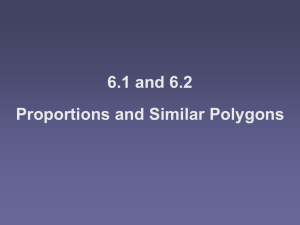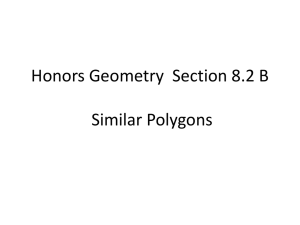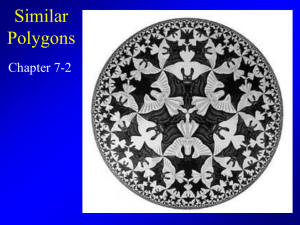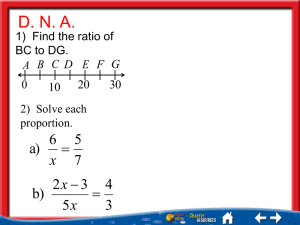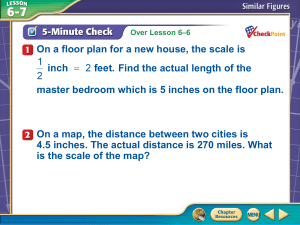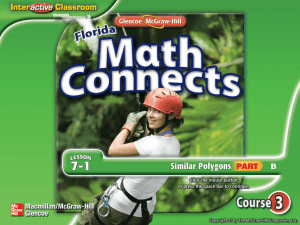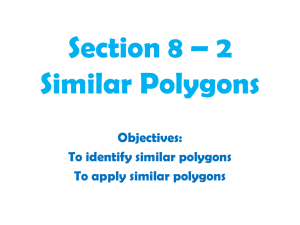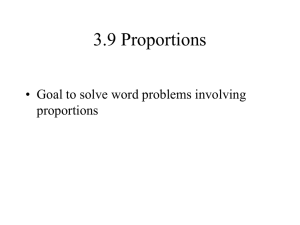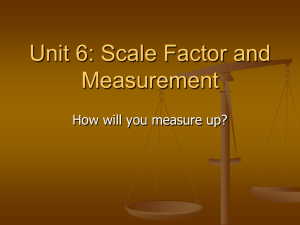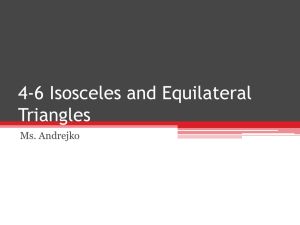6.1 and 6.2 ratios - proportions
advertisement
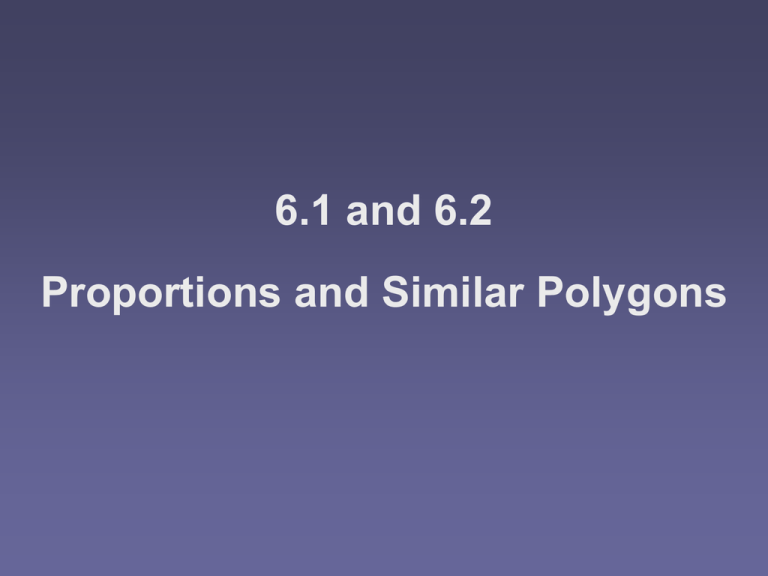
6.1 and 6.2 Proportions and Similar Polygons Objectives Write ratios and use properties of proportions Identify similar polygons Solve problems using scale factors Ratios and Proportions Recall that a ratio is simply a comparison of two quantities. It can be expressed as a to b, a : b, or as a fraction a/b where b ≠ 0. Also, recall that a proportion is an equation stating two ratios are equivalent (i.e. 2/3 = 4/6). Finally, to solve a proportion for a variable, we multiply the cross products, or the means and the extremes. 10/x = 5/7 5x = 70 x = 14 Example 1: The total number of students who participate in sports programs at Central High School is 520. The total number of students in the school is 1850. Find the athlete-to-student ratio to the nearest tenth. To find this ratio, divide the number of athletes by the total number of students. 0.3 can be written as Answer: The athlete-to-student ratio is 0.3. Example 2: Multiple- Choice Test Item In a triangle, the ratio of the measures of three sides is 3:4:5, and the perimeter is 42 feet. Find the measure of the longest side of the triangle. A 10.5 ft Answer: C B 14 ft C 17.5 ft D 37 ft Example 3a: Solve Original proportion Cross products Multiply. Divide each side by 6. Answer: 27.3 Example 3b: Solve Original proportion Cross products Simplify. Add 30 to each side. Divide each side by 24. Answer: –2 Example 4: A boxcar on a train has a length of 40 feet and a width of 9 feet. A scale model is made with a length of 16 inches. Find the width of the model. Because the scale model of the boxcar and the boxcar are in proportion, you can write a proportion to show the relationship between their measures. Since both ratios compare feet to inches, you need not convert all the lengths to the same unit of measure. Example 4: Substitution Cross products Multiply. Divide each side by 40. Answer: The width of the model is 3.6 inches. Similar Polygons When polygons have the same shape but may be different in size, they are called similar polygons. Two polygons are similar iff their corresponding angles are congruent and the measures of their corresponding sides are proportional. We express similarity using the symbol, ~. (i.e. ΔABC ~ ΔPRS) Similar Polygons The order of the vertices in a similarity statement is very important. It identifies the corresponding angles and sides of the polygons. ΔABC ~ ΔPRS A P, B R, C S AB = BC = CA PR RS SP Example 1a: Determine whether the pair of figures is similar. Justify your answer. Q The vertex angles are marked as 40º and 50º, so they are not congruent. Example 1a: Since both triangles are isosceles, the base angles in each triangle are congruent. In the first triangle, the base angles measure and in the second triangle, the base angles measure Answer: None of the corresponding angles are congruent, so the triangles are not similar. Example 1b: Determine whether the pair of figures is similar. Justify your answer. T Thus, all the corresponding angles are congruent. Example 1b: Now determine whether corresponding sides are proportional. The ratios of the measures of the corresponding sides are equal. Answer: The ratio of the measures of the corresponding sides are equal and the corresponding angles are congruent, so Your Turn: Determine whether the pair of figures is similar. Justify your answer. a. Your Turn: Answer: Both triangles are isosceles with base angles measuring 76º and vertex angles measuring 28º. The ratio of the measures of the corresponding sides are equal and the corresponding angles are congruent, Your Turn: Determine whether the pair of figures is similar. Justify your answer. b. Answer: Only one pair of angles are congruent, so the triangles are not similar. Scale Factors When you compare the lengths of corresponding sides of similar figures, you get a numerical ratio called a scale factor. Scale factors are usually given for models of real-life objects. Example 2: An architect prepared a 12-inch model of a skyscraper to look like a real 1100-foot building. What is the scale factor of the model compared to the real building? Before finding the scale factor you must make sure that both measurements use the same unit of measure. 1100(12) 13,200 inches Example 2: Answer: The ratio comparing the two heights is The scale factor is which means that the model is of the real skyscraper. , the height Your Turn: A space shuttle is about 122 feet in length. The Science Club plans to make a model of the space shuttle with a length of 24 inches. What is the scale factor of the model compared to the real space shuttle? Answer: Example 3a: The two polygons are similar. Write a similarity statement. Then find x, y, and UV. Use the congruent angles to write the corresponding vertices in order. Example 3a: Now write proportions to find x and y. To find x: Similarity proportion Cross products Multiply. Divide each side by 4. Example 3a: To find y: Similarity proportion Cross products Multiply. Subtract 6 from each side. Divide each side by 6 and simplify. Example 3a: Answer: Example 3b: The two polygons are similar. Find the scale factor of polygon ABCDE to polygon RSTUV. Example 3b: The scale factor is the ratio of the lengths of any two corresponding sides. Answer: Your Turn: The two polygons are similar. a. Write a similarity statement. Then find a, b, and ZO. Answer: ; b. Find the scale factor of polygon TRAP to polygon Answer: . Example 4: Rectangle WXYZ is similar to rectangle PQRS with a scale factor of 1.5. If the length and width of rectangle PQRS are 10 meters and 4 meters, respectively, what are the length and width of rectangle WXYZ? Write proportions for finding side measures. Let one long side of each WXYZ and PQRS be and one short side of each WXYZ and PQRS be Example 4: Answer: Your Turn: Quadrilateral GCDE is similar to quadrilateral JKLM with a scale factor of If two of the sides of GCDE measure 7 inches and 14 inches, what are the lengths of the corresponding sides of JKLM? Answer: 5 in., 10 in. Example 5: The scale on the map of a city is inch equals 2 miles. On the map, the width of the city at its widest point is inches. The city hosts a bicycle race across town at its widest point. Tashawna bikes at 10 miles per hour. How long will it take her to complete the race? Explore Every equals 2 miles. The distance across the city at its widest point is Example 5: Plan Create a proportion relating the measurements to the scale to find the distance in miles. Then use the formula to find the time. Solve Cross products Divide each side by 0.25. The distance across the city is 30 miles. Example 5: Divide each side by 10. It would take Tashawna 3 hours to bike across town. Examine To determine whether the answer is reasonable, reexamine the scale. If 0.25 inches 2 miles, then 4 inches 32 miles. The distance across the city is approximately 32 miles. At 10 miles per hour, the ride would take about 3 hours. The answer is reasonable. Answer: 3 hours Your Turn: An historic train ride is planned between two landmarks on the Lewis and Clark Trail. The scale on a map that includes the two landmarks is 3 centimeters = 125 miles. The distance between the two landmarks on the map is 1.5 centimeters. If the train travels at an average rate of 50 miles per hour, how long will the trip between the landmarks take? Answer: 1.25 hours Assignment Geometry: Pg. 285 #6 – 20 evens, 28 – 34 all Pg. 293 #12, 14, 18, 20, 28 – 44 evens and 48 Pre-AP Geometry: Pg. 285 #6 – 20 evens, 28 – 34 all Pg. 293 #12 – 48 evens
